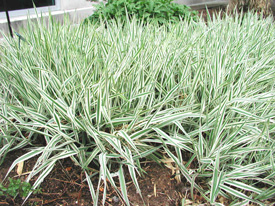Resource Library
Plant of the Week: Ribbon Grass
The University of Arkansas System Division of Agriculture does not promote, support or recommend plants featured in "Plant of the Week." Please consult your local Extension office for plants suitable for your region.
Plant of the Week
Ribbon Grass
Latin: Phalaris arundinacea

Gardens have prime real estate - those beds that are most visible and most valued for planting - and out-of-the-way corners that need cover but generally must survive with a lick and a promise. Left unplanted, these out-of-the-way corners quickly turn into a jungle of weeds, vines and bushes. Groundcovers such as ribbon grass (Phalaris arundinacea var. picta) may be too unruly for more refined parts of the border, but are good choices for these out-of-the-way corners.
Ribbon grass, also called gardener’s garters and feather reed grass, is a rhizomatous perennial grass that grows 12 to 18 inches tall with sprawling stems. Spread is moderate, with rhizomes expanding 4 to 12 inches a year, depending on growing conditions. The better the site, the faster the growth. Only the white variegated form is grown. It has leaves 6 inches long and three-fourths of an inch wide, with broad white stripes running the length of the leaf. The variegation is best in the spring and early summer from new growth, and becomes less distinctive as the summer progresses.
Flowers on the variegated reed grass are rare but can occur in the summer, with open panicles growing up to 3 feet tall and appearing during summer. Seed is not produced in the variegated form, but in the species are small, black seeds. In Latin, Phalaris translates as "shining" in reference to the seeds, one species of which is grown for inclusion in bird seed mixes. The flowering stems have a reed-like appearance, explaining the species epitaph "arundinacea."
This species is native across Asia, Europe and North America where it grows in moist, streamside locations and at the edge of the woods. It will grow in light shade, but prefers sites with some sun.
The variegated ribbon grass is an extremely old clone that Girard describes in his 1633 Herbal as "Lady-lace grass." Matthaeus Lobelius (1538-1616), who published his Plantarum in 1576, used the name of "Gramen pictum" as the technical name for the plant and used the English names of Chameleon Grass or Streaked Grass. The first reference to the variegated form in American catalogs dates back to 1792.
Ribbon grass is banned from sale in several west coast states and is listed as an invasive weed in the Midwest. It has bamboo-like ways and does not make a good companion plant in the border because of its invasive habit. If used in the garden, it should only be planted as a groundcover where its spread can be managed and controlled. In groundcover plantings, it is best in an island bed planting, where a lawn mower can be used on all sides to define the allowed space..
I have grown ribbon grass for about 20 years in my hillside garden in partially shaded sites. I have found it to be only a moderate spreader in partial shade that is prone to be dry. In a sand bed, it spreads rapidly, but was easy to remove when it overextended its desired reach. It can be grown in standing water, but such locations would probably be ill-advised because of the strong growth response it shows to moist and wet conditions.
Ribbon grass is a beautiful grass in the spring and early summer, but by midsummer it is tired and dejected-looking. Mowing the grass back to the ground will rejuvenate the planting and produce fresh leaves for a fall display. It is hardy from zones 4 through 9. Plants are easily propagated by division at any season.
By: Gerald Klingaman, retired
Extension Horticulturist - Ornamentals
Extension News - July 23, 2010
The University of Arkansas System Division of Agriculture does not maintain lists of retail outlets where these plants can be purchased. Please check your local nursery or other retail outlets to ask about the availability of these plants for your growing area.